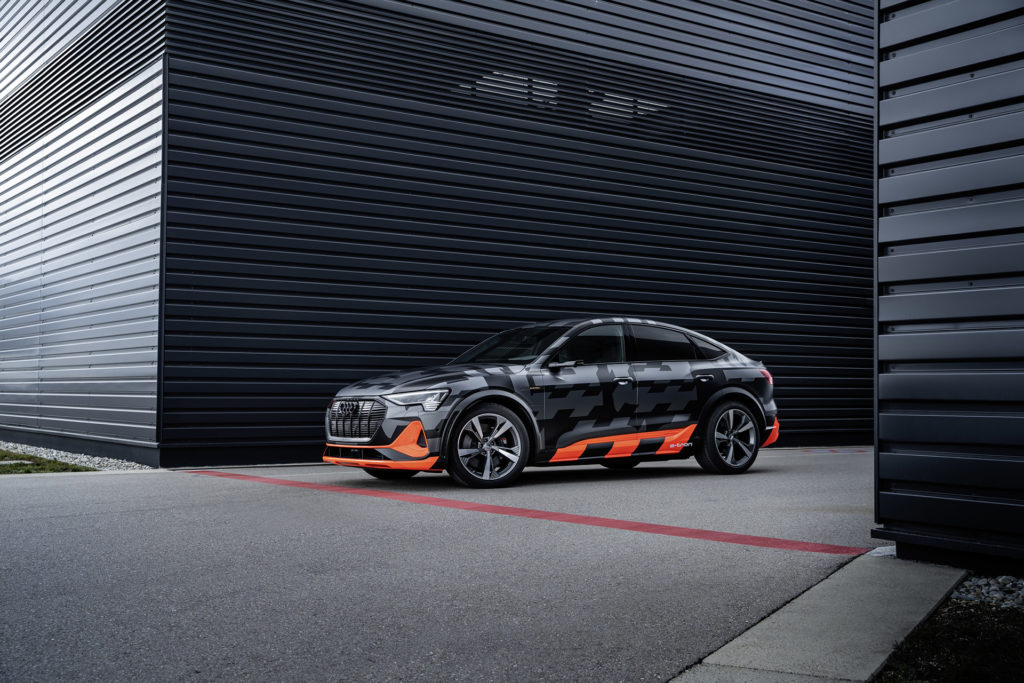Audi is systematically moving forward with its e-offensive: The Audi e-tron and the Audi e-tron Sportback are becoming more agile, sharper and more dynamic as S models. The three electric motors, two of which are located on the rear axle, together provide 370 kW of boost power and 973 Nm of torque.
This allows the two purely electrically driven models to accelerate to 100 km/h in 4.5 seconds. The intelligent drive control raises vehicle safety, and dynamic handling in particular, to a new level.
In addition to the electric all-wheel drive, there is the electric torque vectoring with active and fully variable torque distribution on the rear axle.
Dynamism 2.0: the driving experience
The driving experience of the two prototypes for the Audi e-tron S-models cannot fail to impress with its level of dynamism, agility and traction increased once more.
In the S gear, both cars go from a standstill to 100 km/h in 4.5 seconds – almost seamlessly and nearly no noise – propulsion does not end until 210 km/h, limited electronically.
Thanks to a powerful cooling system, the drive gives the full boost power of 370 kW and 973 Nm of torque in reproducible form for eight seconds in each case. The nominal values in the D gear without boost are 320 kW and 808 Nm.
In terms of handling, the electric S models provide outstanding agility and traction: They can accelerate from a curve as dynamically as a sports car, their drive character is much more focused on the rear wheels and much sportier in nature.
If the ESC stabilisation control is set to “Sport” and the Audi drive select dynamic handling system is set to maximum performance with “Dynamic” mode, the drive layout facilitates a high level of transverse dynamics and, on request, controlled drifts as well.
The driving behaviour is predictable at all times, and is characterised by an ultra-high level of safety and reliability.

The drive layout: three electric motors in the future mass production
The new Audi e-tron S models will be the first electric cars worldwide with three motors in mass production.
Their drive layout is based on the concept with two different asynchronous motors (ASM); the e-tron product line was designed in modular form in line with this from the start.
The larger electric motor, which powers the rear axle in the Audi e-tron 55 models (current consumption combined in kWh/100 km*: 26.4–21.9 (WLTP); 23.1–20.6 (NEDC), combined CO2 emissions in g/km: 0), has now been installed on the front axle in an adapted design and configured for 124 kW of power, or 150 kW in the boost.
The smaller electric motor now works in a modified form in the rear, together with a counterpart that is identical in design; together, they offer 196 kW of power, or 264 kW in the boost.
Innovation from the quattro pioneer: twin motor with electrical torque vectoring
The drive has been programmed for efficiency in everyday life; in normal driving mode, only the rear electric motors work. The front drive is unpowered but switches itself on – with the driver barely noticing – if the driver needs more power.
It also switches on predictively if the grip declines. It does so when friction values are low and during rapid cornering. The electric all-wheel drive is complemented by a further technical innovation in the form of electrical torque vectoring, which brings the advantages of the conventional sport differential into the electric era.
Each one of the rear electric motors sends the drive forces directly to the wheel via a transmission; there is no longer a mechanical differential.
40 years following the launch of quattro technology, Audi is thus raising the principle of the four powered wheels to a completely new level of technology.
The result is more agile driving and self-steering characteristics, and thus a higher cornering speed.
One further advantage is the traction. If, during acceleration, a rear wheel comes into contact with a road surface with a low friction value, i.e. if the road surface is covered in black ice or has a loose subsurface, the moment can be distributed precisely and quickly between the two motors.
The full moment is gradually distributed to the wheel with powerful traction, while the wheel with low traction continues moving with almost no moment.
Up to 150 kW: peak power, even during charging
When the driver is on the road, the electric S models can be charged with up to 150 kW of direct current power (HPC), such as in the Ionity network.
This means that charging from 5 to 80% only takes around half an hour. An important factor for this is the elaborate thermal management system with a standard heat pump, which cools and heats the battery, the interior and the electric motors with four circuits.
In addition, the Audi models will also be able to charge with up to 11 kW of alternating current (AC).









